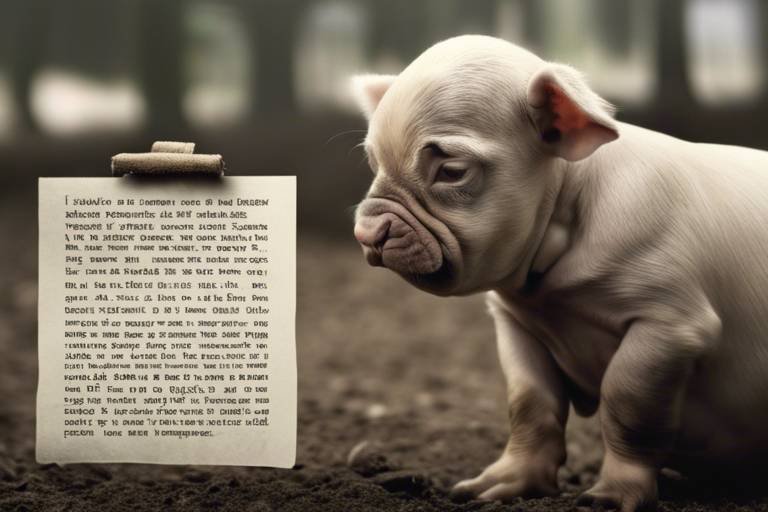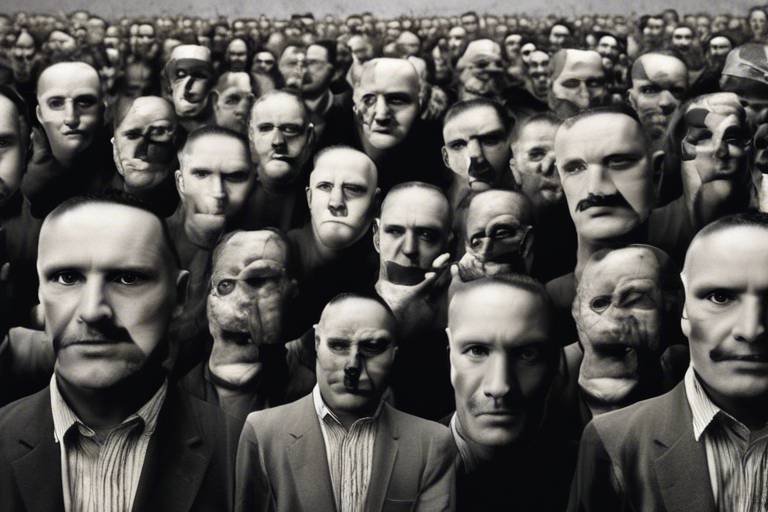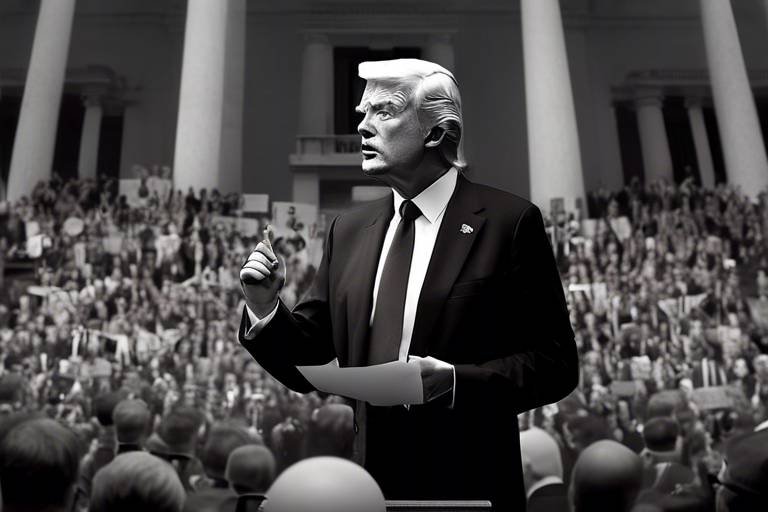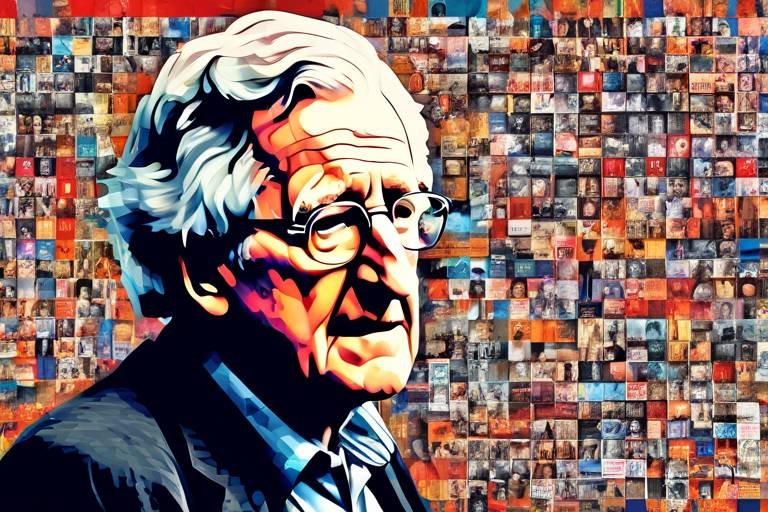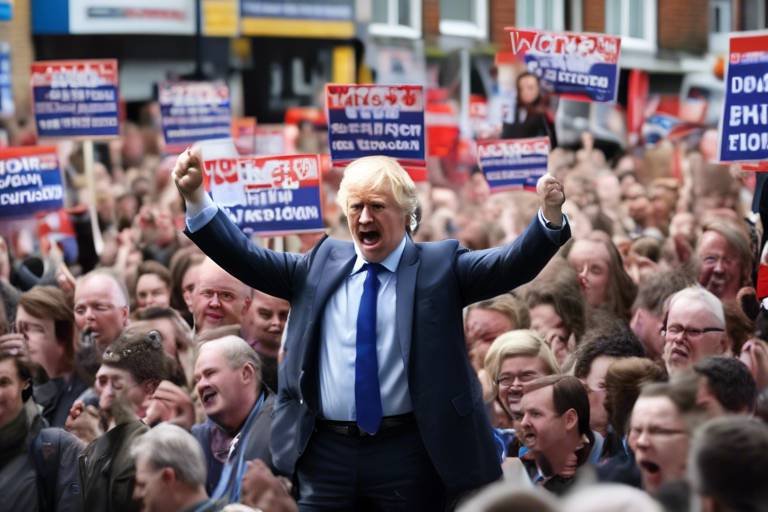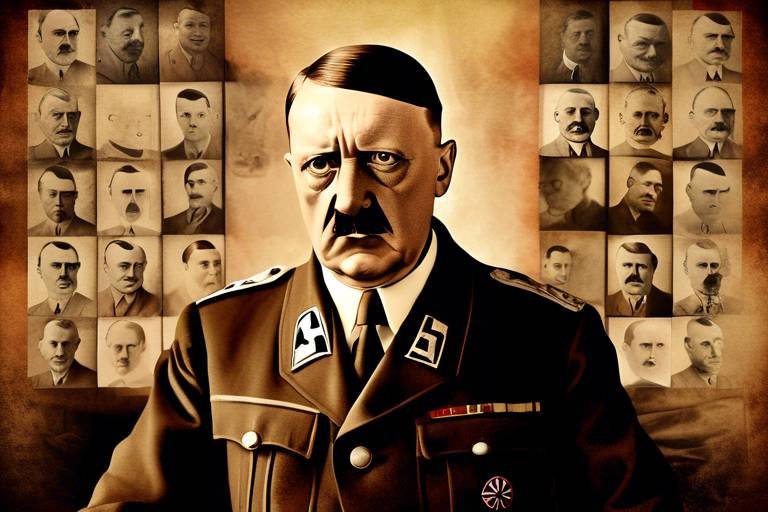Philosophy and the Politics of Animal Welfare
In today's world, the conversation surrounding animal welfare is not just a matter of ethics; it is a complex interplay of philosophical thought and political action. This intersection raises pressing questions: How do we define our responsibilities toward non-human animals? What ethical frameworks guide our decisions? And how do these considerations translate into laws and societal norms? Understanding the politics of animal welfare requires us to delve into the philosophical underpinnings that shape our views and policies. It’s a bit like peeling an onion; each layer reveals deeper insights into our collective attitudes and actions regarding the treatment of animals.
At the heart of this discussion lies the recognition that animals are sentient beings capable of experiencing pain, joy, and everything in between. This understanding challenges us to reconsider our long-held beliefs about human superiority and the rights of other species. The philosophical debates surrounding animal welfare are not just academic; they have real-world implications that affect legislation, advocacy, and our daily choices. As we explore this intricate relationship, we will uncover how various ethical frameworks, historical perspectives, and contemporary debates inform the policies that govern animal welfare.
As we embark on this journey, it’s essential to recognize that the way we treat animals reflects our values as a society. Whether it’s through legislation aimed at protecting endangered species, regulations on factory farming, or the promotion of humane treatment in research, the political landscape is deeply intertwined with our philosophical beliefs. The choices we make today will shape the future of animal welfare, influencing not only the lives of animals but also the moral fabric of our communities.
In the following sections, we will dissect the ethical frameworks that guide our understanding of animal rights, trace the historical evolution of animal welfare, and examine the legislative measures that have emerged in response to these philosophical discussions. We will also consider the role of public perception and grassroots movements in shaping animal welfare policies. Ultimately, this exploration aims to highlight the profound impact that philosophy and politics have on the lives of non-human animals and the ethical responsibilities we bear as stewards of the Earth.
- What is the significance of animal welfare in contemporary society? Animal welfare is crucial as it reflects our ethical values and responsibility towards sentient beings, influencing legislation and public opinion.
- How do philosophical theories affect animal rights? Different philosophical frameworks, such as utilitarianism and deontology, provide varied perspectives on the moral consideration of animals, shaping our ethical and legal standards.
- What role do grassroots movements play in animal welfare? Grassroots movements are vital for raising awareness, influencing public opinion, and advocating for legislative changes that protect animal rights.
- How does media representation impact animal welfare policies? Media representation plays a significant role in shaping public perception, which in turn affects advocacy efforts and the political landscape surrounding animal rights.

The Ethical Frameworks of Animal Rights
When we talk about animal rights, we inevitably dive into the deep waters of ethical theories that shape our understanding of how we should treat our non-human companions. Two of the most influential frameworks in this arena are utilitarianism and deontology. Each of these philosophies offers a unique lens through which we can evaluate the moral standing of animals and the ethical implications of our actions toward them.
Utilitarianism, championed by thinkers like Jeremy Bentham and John Stuart Mill, advocates for the greatest happiness principle. This means that the rightness of an action is determined by its consequences. In the context of animal welfare, utilitarianism prompts us to consider the balance between human interests and animal suffering. For instance, if a factory farm maximizes profits but inflicts immense suffering on animals, a utilitarian perspective would challenge the morality of such practices. The fundamental question becomes: do the benefits to humans justify the harm caused to animals?
On the other hand, deontological ethics, most notably associated with Immanuel Kant, posits that certain actions are inherently right or wrong, regardless of their outcomes. From this viewpoint, animals possess intrinsic value and deserve to be treated with respect and dignity. This ethical framework suggests that exploiting animals for human gain is morally unacceptable, regardless of the potential benefits. It raises thought-provoking questions: Should we consider an animal's capacity to suffer as a basis for moral consideration? What obligations do we have to ensure their welfare, even if it comes at a cost to our convenience or enjoyment?
These ethical frameworks significantly influence public policy and societal attitudes toward animal welfare. For instance, legislation regarding animal testing, factory farming, and wildlife conservation often reflects the underlying ethical beliefs of a society. As we navigate these complex issues, it becomes clear that our ethical stance on animal rights shapes not only how we legislate but also how we perceive and treat animals in our daily lives.
Moreover, it’s essential to recognize that these frameworks are not mutually exclusive. Many advocates for animal rights draw from both utilitarian and deontological principles to create a more comprehensive approach to animal welfare. This blending of philosophies can lead to a more nuanced understanding of the ethical dilemmas we face. In a world where animal exploitation is rampant, engaging with these ethical theories is crucial for anyone interested in advocating for change.
In summary, the ethical frameworks of animal rights provide a rich tapestry of ideas that challenge us to reconsider our relationships with animals. Whether we lean more towards utilitarianism or deontology, the conversation is vital. As society continues to evolve, so too will our understanding of animal rights, leading to potential changes in legislation and public perception. The journey toward better animal welfare is ongoing, and it begins with ethical reflection and discourse.
- What is the difference between utilitarianism and deontology in animal rights?
Utilitarianism focuses on the consequences of actions and aims for the greatest happiness, while deontology emphasizes the inherent rights of individuals, regardless of the outcomes. - How do ethical frameworks influence animal welfare legislation?
Ethical beliefs shape public opinion and can lead to changes in laws regarding animal testing, farming practices, and conservation efforts. - Can these ethical frameworks coexist?
Yes, many advocates combine elements of both utilitarianism and deontology to create a more comprehensive approach to animal welfare.

Historical Perspectives on Animal Welfare
The journey of animal welfare has been a long and winding road, shaped by cultural, religious, and philosophical developments throughout history. Understanding this evolution is essential for grasping the modern landscape of animal rights and welfare. From ancient civilizations that revered animals to contemporary societies grappling with ethical dilemmas, the treatment of animals has always reflected broader societal values. For instance, in ancient Egypt, animals were often seen as sacred beings, deserving of respect and protection. This reverence contrasts sharply with periods in history where animals were viewed merely as property, devoid of rights or consideration.
As we trace the key milestones in the historical journey of animal welfare, we see a pattern of gradual awakening to the moral implications of our relationship with non-human beings. The Middle Ages brought about a mix of compassion and cruelty, where animals were sometimes subjected to harsh treatment in the name of entertainment or labor. Yet, even during these dark times, there were voices advocating for better treatment, hinting at the emerging awareness of animal rights.
The Renaissance marked a significant turning point, as humanism began to flourish. Thinkers started to question the hierarchical view of nature, suggesting that animals, too, possess intrinsic value. This period ignited discussions that would later influence Enlightenment philosophers, who laid the groundwork for modern animal rights discourse. These intellectuals argued for the moral consideration of animals, pushing against the status quo and advocating for a more ethical treatment of all sentient beings.
During the 19th century, the first formal movements advocating for animal welfare emerged, driven by the growing awareness of animal suffering in industrialized societies. The establishment of organizations such as the Royal Society for the Prevention of Cruelty to Animals (RSPCA) in England marked a significant milestone. These organizations aimed to protect animals from cruelty and promote humane treatment. The legal frameworks that began to take shape during this time laid the foundation for future legislation aimed at safeguarding animal rights.
Fast forward to the 20th century, and we see a surge in activism and legal reforms across the globe. The post-World War II era witnessed a heightened awareness of animal welfare issues, spurred by the rise of the animal rights movement. Activists began to challenge not only the treatment of companion animals but also the ethics of factory farming and animal experimentation. This period was characterized by the publication of influential works, such as Peter Singer's "Animal Liberation," which argued compellingly for the moral consideration of animals based on their capacity to suffer.
Today, the historical perspectives on animal welfare remind us that our treatment of animals is not merely a matter of personal ethics but a reflection of our societal values. As we continue to evolve in our understanding of animal rights, it becomes increasingly important to acknowledge the past. By learning from history, we can better shape a future where animals are treated with the dignity and respect they deserve.
- What is the significance of historical perspectives on animal welfare? Historical perspectives help us understand how societal values have evolved regarding animals and inform current discussions on animal rights.
- How did Enlightenment thinkers influence animal welfare? Enlightenment thinkers questioned traditional views of animals, advocating for their moral consideration and influencing modern animal rights discourse.
- What role did the 19th century play in animal welfare movements? The 19th century saw the emergence of formal animal welfare organizations that aimed to protect animals from cruelty and promote humane treatment.
- Why is it important to consider the history of animal welfare? Understanding the history of animal welfare helps us recognize the progress made and the challenges that still exist in advocating for animal rights today.

The Role of Enlightenment Thinkers
The Enlightenment era, often dubbed the Age of Reason, was a pivotal period that reshaped many aspects of human thought, including our relationship with non-human animals. Enlightenment thinkers such as Immanuel Kant, Jean-Jacques Rousseau, and John Stuart Mill contributed significantly to the philosophical discourse surrounding animal rights and welfare. Their ideas not only challenged existing norms but also laid the groundwork for modern ethical considerations regarding animals, pushing society to reconsider how we perceive and treat them.
For instance, Rousseau argued for the inherent goodness of nature, suggesting that humans, in their natural state, possess an innate compassion for animals. He believed that civilization often corrupts this natural empathy, leading to a disconnect between humans and the creatures with whom they share the planet. Rousseau's perspective invites us to reflect on our responsibilities toward animals, emphasizing that a return to our natural instincts could foster a more humane society.
Meanwhile, Kant introduced a more complex view. He argued that while animals are not rational beings in the same way humans are, this does not justify cruelty towards them. Kant believed that our treatment of animals reflects our moral character and affects our interactions with other humans. This notion serves as a compelling argument for the ethical treatment of animals, suggesting that a society that respects animal welfare is likely to be more compassionate and just overall.
On the other hand, John Stuart Mill offered a utilitarian perspective, focusing on the consequences of our actions. Mill posited that the moral worth of an action is determined by its contribution to overall happiness, which includes the well-being of animals. He raised essential questions about the balance between human interests and animal suffering, urging society to consider how our choices impact all sentient beings. This utilitarian approach has significantly influenced contemporary debates about animal rights, as it encourages a broader consideration of the ethical implications of our actions.
In essence, the Enlightenment thinkers collectively shaped the philosophical foundation for animal rights. Their discussions about morality, empathy, and the nature of happiness continue to resonate in modern ethical debates. By examining their ideas, we can better understand the evolution of animal welfare and the ongoing struggle to achieve a more compassionate society. As we navigate the complexities of animal rights today, the insights of these thinkers remind us that our moral obligations extend beyond our species, urging us to advocate for those who cannot speak for themselves.
- What is the significance of Enlightenment thinkers in animal welfare?
Their ideas helped to challenge societal norms and laid the groundwork for modern ethical considerations regarding animals. - How did Rousseau view the relationship between humans and animals?
Rousseau believed that humans have an innate compassion for animals that is often corrupted by civilization. - What was Kant's perspective on animal rights?
Kant argued that while animals are not rational beings, our treatment of them reflects our moral character. - How does Mill's utilitarianism apply to animal welfare?
Mill emphasized that the consequences of our actions, including their impact on animal well-being, should be considered in ethical decision-making.

Rousseau and the Natural State
When we dive into the philosophical musings of Jean-Jacques Rousseau, we find ourselves exploring the concept of the "natural state," a theory that profoundly influences our understanding of human-animal relationships. Rousseau argued that humans, in their natural state, were inherently good and lived harmoniously with nature, including animals. This perspective invites us to question the ethical implications of our treatment of non-human beings. Are we, as a society, straying too far from this natural harmony?
Rousseau's ideas challenge the prevailing notion that humans are superior to animals. He believed that the artificial constructs of society often lead to the suffering of both humans and animals alike. In his view, animals are not mere resources for human use, but rather beings deserving of respect and consideration. This leads us to ponder: if we recognize animals as part of our natural world, shouldn't we strive to protect their welfare just as we would our own?
In the context of animal welfare, Rousseau's philosophy encourages us to reflect on our moral obligations. He posited that the more we cultivate our societal structures, the more we risk alienating ourselves from our natural instincts, which include compassion and empathy towards all living beings. This is particularly relevant today, as we grapple with issues like factory farming, habitat destruction, and the exploitation of animals for entertainment. By embracing Rousseau's vision of a more natural state, we could foster a society that prioritizes the welfare of animals, recognizing their intrinsic value.
To further illustrate Rousseau's impact on animal rights discourse, we can consider the following key points:
- Human-Animal Connection: Rousseau emphasized the importance of understanding our connection with animals, advocating for a more empathetic approach to their treatment.
- Moral Consideration: His philosophy suggests that moral consideration should extend beyond humans, urging us to acknowledge the suffering of animals.
- Critique of Civilization: Rousseau criticized modern civilization for its tendency to prioritize human desires over the welfare of animals, highlighting the need for a balance.
In essence, Rousseau's exploration of the natural state serves as a powerful reminder of the ethical responsibilities we hold towards animals. As we continue to navigate the complexities of animal welfare, his ideas challenge us to reconsider our actions and strive for a more compassionate coexistence with all living beings. By understanding Rousseau's perspective, we can ignite a dialogue that fosters respect for animals and drives meaningful change in our society.
- What is Rousseau's concept of the natural state? Rousseau's natural state refers to the idea that humans are inherently good and that our natural instincts should guide our interactions with the world, including animals.
- How does Rousseau's philosophy influence animal welfare? His ideas encourage empathy and moral consideration for animals, advocating for their rights and welfare in society.
- Why is Rousseau's critique of civilization important? It highlights the dangers of prioritizing human interests at the expense of animals, urging a reevaluation of our societal norms and practices.

Mill’s Utilitarianism and Animals
John Stuart Mill, a prominent figure in the realm of philosophy, introduced a nuanced approach to utilitarianism that has profound implications for how we consider the moral status of animals. At its core, utilitarianism evaluates the morality of actions based on their outcomes, specifically the principle of the greatest happiness for the greatest number. This raises an intriguing question: do animals count in this equation? Mill's perspective suggests that they should, as he emphasized the importance of considering the pleasures and pains of all sentient beings, not just humans.
In Mill's view, the capacity to experience pleasure and suffering is what grants moral consideration. This revolutionary idea challenges traditional notions that prioritize human interests above all else. By extending the utilitarian framework to include animals, Mill invites us to reflect on the ethical implications of our actions. For instance, when we consider practices such as factory farming, we must weigh the immense suffering endured by animals against the economic benefits derived from their exploitation. This leads to a critical examination of whether the happiness generated for humans justifies the pain inflicted on non-human animals.
Moreover, Mill's utilitarianism prompts us to consider the quality of happiness experienced by different beings. He famously argued that not all pleasures are equal; intellectual and moral pleasures are superior to mere physical ones. This distinction raises further questions about the experiences of animals. Are their lives filled with suffering, or do they experience joy and fulfillment in ways that deserve our respect? Understanding the complexities of animal emotions can help us make more informed decisions regarding their welfare.
To illustrate Mill's utilitarian approach, consider the following table that contrasts the interests of humans with those of animals:
| Interest | Humans | Animals |
|---|---|---|
| Capacity for Suffering | High | High |
| Capacity for Happiness | Varied | Varied |
| Societal Value | Significant | Often overlooked |
This table illustrates that while both humans and animals can suffer and experience happiness, societal values often place human interests at the forefront. Mill's utilitarianism challenges this hierarchy by advocating for a more equitable consideration of all sentient beings. By acknowledging that animals, like humans, have the capacity to feel pain and joy, we can begin to reshape our ethical landscape.
In conclusion, Mill's utilitarianism serves as a powerful lens through which we can examine our moral obligations toward animals. It compels us to ask difficult questions about the consequences of our actions and the ethical implications of our choices. As we navigate the complexities of animal welfare, Mill's insights remind us that the pursuit of happiness should not come at the expense of another being's suffering. In a world where the lives of countless animals are at stake, embracing a utilitarian perspective may be the key to fostering a more compassionate society.
- What is utilitarianism? Utilitarianism is an ethical theory that suggests the best action is the one that maximizes happiness and reduces suffering for the greatest number of beings.
- How does Mill's utilitarianism differ from other forms of utilitarianism? Mill emphasizes the quality of pleasures, arguing that intellectual and moral pleasures are superior to physical ones, unlike some other utilitarian theories that may treat all pleasures as equal.
- Why should animals be considered in utilitarian ethics? Animals are capable of experiencing pleasure and suffering, thus their interests should be included in moral considerations to ensure a more just and compassionate society.

Contemporary Philosophical Debates
The landscape of animal welfare is not just shaped by laws and policies; it is profoundly influenced by contemporary philosophical debates that question the very foundations of our moral considerations. As we navigate this complex terrain, we encounter a myriad of perspectives that challenge us to rethink our relationships with non-human animals. One of the central issues in these discussions is the moral status of animals. Are they mere property, or do they possess intrinsic rights that warrant protection? This question is not just academic; it has real-world implications for how society treats animals in various contexts, from factory farming to scientific research.
At the heart of these debates lies the tension between anthropocentrism—the belief that human beings are the most important entities in the universe—and more egalitarian views that advocate for the moral consideration of all sentient beings. Proponents of animal rights argue that the capacity to suffer, not species membership, should determine moral standing. This perspective challenges traditional views that prioritize human interests over those of animals, often leading to heated discussions about ethical consumption, animal testing, and habitat preservation.
Moreover, contemporary philosophy has seen the emergence of various ethical theories that further complicate our understanding of animal welfare. For instance, virtue ethics emphasizes character and moral virtues, suggesting that a compassionate character naturally extends care to animals. In contrast, contractarianism posits that moral obligations arise from social contracts, raising questions about whether animals can be included in such agreements. These differing viewpoints reflect the rich tapestry of thought surrounding animal rights and welfare, showcasing how philosophical inquiry can illuminate ethical dilemmas.
In addition to these theoretical frameworks, practical implications arise when we consider how these philosophical debates influence public policy. For example, the growing recognition of animal sentience has led to legislative changes in many countries, where laws are being reformed to reflect a deeper understanding of animal welfare. As a result, we see an increasing number of policies aimed at reducing animal suffering in industries such as agriculture and entertainment.
Furthermore, the role of advocacy groups cannot be overlooked. Organizations dedicated to animal rights often utilize philosophical arguments to sway public opinion and influence policymakers. They highlight the ethical implications of animal suffering, urging society to adopt more humane practices. This intersection of philosophy and activism demonstrates how theoretical discussions can lead to tangible changes in legislation and societal norms.
As we delve deeper into these contemporary debates, it is essential to recognize the multifaceted nature of animal welfare issues. They encompass not only ethical considerations but also cultural, economic, and environmental factors. The dialogue surrounding animal rights is dynamic and evolving, reflecting broader societal changes and advancements in our understanding of sentience and welfare. Ultimately, the ongoing philosophical debates serve as a reminder that our relationships with animals are not static; they are constantly shaped by our evolving moral landscapes.
- What is the main argument for animal rights? The primary argument for animal rights is that animals, as sentient beings capable of suffering, deserve moral consideration and protection from harm, irrespective of their utility to humans.
- How do philosophical debates influence animal welfare legislation? Philosophical debates shape public opinion and ethical frameworks, which in turn influence policymakers to adopt laws that reflect a growing awareness of animal welfare and rights.
- What role do advocacy groups play in animal welfare? Advocacy groups raise awareness, educate the public, and lobby for legislative changes by using philosophical arguments to highlight the ethical implications of animal suffering.

Legislation and Policy on Animal Welfare
When it comes to animal welfare, legislation and policy act as the backbone of societal change, ensuring that animals are treated with the dignity and respect they deserve. Laws governing animal rights vary widely across different countries and regions, reflecting a complex interplay of cultural values, ethical considerations, and political will. The evolution of these legal frameworks has been driven by a growing recognition of the sentience of non-human animals and the moral obligations humans have toward them.
In many places, animal welfare laws have been established to prevent cruelty, regulate the treatment of animals in agriculture, and protect wildlife. These laws often arise from grassroots movements that advocate for better treatment of animals, pushing for legislative changes that reflect a more ethically conscious society. For instance, in the United States, the Animal Welfare Act (AWA) was enacted in 1966, marking a significant step towards federal protection of animals used in research, exhibition, and transport. However, critics argue that the AWA has significant loopholes, particularly concerning farm animals and pets, which are often excluded from its protections.
Moreover, the political process involved in enacting animal welfare laws can be quite intricate. It typically involves a combination of public advocacy, lobbying by animal rights organizations, and sometimes, opposition from industries such as agriculture and entertainment that may be resistant to regulatory changes. This tug-of-war between competing interests often results in legislation that is a compromise rather than a comprehensive solution. For example, while some laws may enhance protections for certain animals, they may simultaneously allow for practices that many consider inhumane.
To provide a clearer picture of the current state of animal welfare legislation, consider the following table that outlines some significant laws and regulations across different countries:
| Country | Key Legislation | Year Enacted |
|---|---|---|
| United States | Animal Welfare Act (AWA) | 1966 |
| United Kingdom | Animal Welfare Act | 2006 |
| Germany | Animal Protection Act | 1972 |
| Australia | Animal Welfare Act | 2012 |
Internationally, treaties and agreements play a crucial role in shaping animal welfare policies. Organizations such as the World Organisation for Animal Health (OIE) promote standards that member countries are encouraged to adopt. These international frameworks help to harmonize animal welfare laws across borders, making it easier to address issues like animal trafficking and exploitation on a global scale.
Grassroots movements have also been pivotal in influencing animal welfare legislation. Advocacy groups work tirelessly to raise public awareness and garner support for animal rights, often leading to significant changes in laws. For example, campaigns against factory farming have resulted in bans on certain cruel practices, such as battery cages for hens in various countries. This demonstrates the power of collective action and public sentiment in driving legislative change.
As we look to the future, it is essential to continue advocating for stronger animal welfare laws that reflect our evolving understanding of animals as sentient beings deserving of protection. The journey toward comprehensive animal rights legislation is ongoing, and it requires the commitment of both individuals and organizations to push for meaningful change.
- What is the Animal Welfare Act? The Animal Welfare Act is a federal law in the United States that regulates the treatment of animals in research, exhibition, and transport.
- How do grassroots movements influence animal welfare legislation? Grassroots movements raise public awareness and advocate for change, often leading to significant legal reforms regarding animal rights.
- Are there international laws protecting animal welfare? Yes, various international treaties and agreements aim to establish standards for the treatment of animals globally.

International Treaties and Agreements
When it comes to the protection of animal rights on a global scale, play a pivotal role. These legal frameworks not only establish standards for animal welfare but also promote cooperation among nations to ensure that animals are treated humanely. One of the most significant agreements is the Universal Declaration on Animal Welfare, which aims to encourage governments to adopt and enforce legislation that protects animals from unnecessary suffering. Although it is not legally binding, its moral authority has spurred many countries to take action.
Another key treaty is the Convention on International Trade in Endangered Species of Wild Fauna and Flora (CITES), which regulates international trade in wildlife and aims to ensure that trade does not threaten the survival of species in the wild. CITES has been instrumental in protecting various endangered species from illegal trafficking, thus addressing both animal welfare and conservation concerns.
Moreover, the European Union's Animal Welfare Legislation sets a high standard for animal rights within its member states. The EU has implemented a series of directives and regulations that govern the treatment of animals in various sectors, including agriculture, research, and transport. These laws reflect a growing recognition of animals as sentient beings deserving of protection and care. For instance, the EU Animal Welfare Strategy outlines comprehensive measures to improve the welfare of animals across Europe, demonstrating a commitment to uphold their rights.
In addition to these treaties, numerous regional agreements aim to address animal welfare issues specific to certain areas. For example, the African Convention on the Conservation of Nature and Natural Resources emphasizes the importance of protecting wildlife and their habitats, while the Inter-American Convention for the Protection and Conservation of Sea Turtles focuses on safeguarding marine animals. These agreements showcase the diverse approaches taken by different regions to address animal welfare concerns.
Despite the existence of these treaties, challenges remain in their implementation and enforcement. Many countries struggle with inadequate resources, lack of political will, or corruption, which can hinder the effective protection of animal rights. Thus, the role of grassroots movements and advocacy groups becomes crucial in holding governments accountable and ensuring that international agreements translate into meaningful action on the ground.
In conclusion, international treaties and agreements serve as essential tools for promoting animal welfare globally. They not only set standards for humane treatment but also foster collaboration among nations to protect the rights of animals. However, to achieve real change, it is vital for these agreements to be supported by robust national legislation and active public engagement.
- What is the Universal Declaration on Animal Welfare?
It is a non-binding declaration that encourages countries to adopt laws protecting animals from unnecessary suffering.
- How does CITES help animals?
CITES regulates international trade in endangered species to prevent their extinction due to over-exploitation.
- What role do grassroots movements play in animal welfare?
They advocate for stronger laws and hold governments accountable for implementing international treaties.

Grassroots Movements and Advocacy
Grassroots movements have emerged as powerful catalysts for change in the realm of animal welfare, highlighting the profound impact that ordinary citizens can have on legislative processes and public perception. These movements often begin at the local level, where passionate individuals come together to advocate for the rights and well-being of animals. By mobilizing communities, raising awareness, and engaging in direct action, grassroots organizations have played a pivotal role in shaping animal welfare policies across the globe.
One of the key strengths of grassroots movements is their ability to connect with the public on a personal level. Unlike large organizations that may seem distant or bureaucratic, grassroots advocates often share their own stories and experiences, making the cause relatable. This personal touch fosters a sense of community and encourages more people to join the movement. For instance, campaigns that highlight the plight of animals in factory farming or those used in entertainment can evoke strong emotional responses, prompting individuals to take action.
Additionally, grassroots movements often utilize social media as a powerful tool for advocacy. Platforms like Facebook, Twitter, and Instagram allow activists to reach a broad audience quickly and effectively. Through compelling visuals, informative posts, and engaging narratives, these movements can spark conversations and drive public interest in animal welfare issues. For example, viral campaigns that expose animal cruelty have led to increased support for legislative changes, demonstrating the tangible impact of online activism.
Moreover, grassroots movements have a unique ability to influence legislation by mobilizing public opinion. When a significant number of individuals express their concerns about animal welfare, lawmakers often take notice. This phenomenon can be seen in various successful campaigns that have led to the enactment of stricter animal protection laws. For instance, when communities rally together to oppose puppy mills or circuses that exploit animals, they create a collective voice that is hard for politicians to ignore. The pressure from constituents can result in meaningful policy changes that prioritize animal rights.
In conclusion, grassroots movements and advocacy play a crucial role in advancing animal welfare. Their ability to engage the public, leverage social media, and influence legislation makes them indispensable in the fight for animal rights. As these movements continue to grow, they not only change laws but also shift societal attitudes toward animals, fostering a more compassionate world for all living beings.
- What are grassroots movements? Grassroots movements are community-led initiatives that aim to bring about social or political change, often starting from the local level.
- How can I get involved in animal welfare advocacy? You can start by joining local animal welfare organizations, participating in campaigns, or using social media to raise awareness about animal rights issues.
- What impact do grassroots movements have on legislation? Grassroots movements can significantly influence legislation by mobilizing public opinion and demonstrating widespread support for animal welfare issues.
- Why is social media important for animal welfare advocacy? Social media allows activists to reach a larger audience quickly, share compelling stories, and create viral campaigns that draw attention to animal welfare issues.

The Impact of Public Perception
Public perception plays a pivotal role in shaping animal welfare policies. Our collective attitudes toward animals are not just reflections of personal beliefs; they are deeply intertwined with cultural narratives, media portrayals, and societal values. When we think about how society treats animals, it’s essential to recognize that these perceptions can either propel animal welfare initiatives forward or hold them back. For instance, consider how a single viral video showcasing animal cruelty can spark outrage, leading to protests, petitions, and ultimately, legislative changes. This illustrates the immense power of public sentiment in driving political action.
One of the most significant factors influencing public perception is media representation. The media has the ability to shape narratives around animal welfare, often framing issues in ways that resonate with the public. Documentaries like "Blackfish," which exposed the treatment of orcas in captivity, have not only raised awareness but have also led to substantial shifts in public opinion and policy. Such films can ignite a firestorm of activism, pushing lawmakers to reconsider existing regulations and advocate for stronger protections. Thus, the way animals are depicted in media—whether through documentaries, news reports, or social media campaigns—can profoundly impact how society views their rights and welfare.
Moreover, cultural influences significantly affect how different societies prioritize animal welfare. In some cultures, animals are viewed primarily as companions or family members, leading to stronger advocacy for their rights. In contrast, other cultures may prioritize livestock for economic reasons, which can complicate discussions around animal rights. These differing perspectives can create tension in international dialogues about animal welfare policies. For example, countries with strict animal welfare laws often clash with those that maintain more lax regulations based on cultural practices. Understanding these nuances is crucial for developing effective global policies that respect cultural differences while advocating for animal rights.
To illustrate the impact of public perception on animal welfare, consider the following table that outlines various cultural attitudes toward animals and how they translate into legislative action:
| Country | Cultural Attitude | Legislative Action |
|---|---|---|
| United States | Animals as companions | Animal Welfare Act, various state laws |
| India | Religious reverence for cows | Ban on cow slaughter in many states |
| China | Livestock for food | Emerging regulations but less stringent |
| Germany | Strong animal rights advocacy | Comprehensive animal protection laws |
As we can see, the interplay between cultural attitudes and legislative actions varies widely around the globe. This variability highlights the necessity for tailored advocacy efforts that consider local beliefs and practices. Activists aiming to promote animal rights must navigate these cultural landscapes carefully, using strategies that resonate with local populations while pushing for progressive change.
In conclusion, the impact of public perception on animal welfare is undeniable. It is not merely a backdrop; it is an active force that can drive change or stifle progress. As we continue to engage in discussions about animal rights, it is essential to recognize the power of our collective voices and the role that media and culture play in shaping our understanding of these issues. By fostering informed public opinion, we can create a more compassionate world for all beings, human and non-human alike.
- How does media representation affect animal welfare? Media representation can significantly influence public perception, leading to increased awareness and advocacy for animal rights.
- Why are cultural attitudes important in animal welfare discussions? Cultural attitudes shape how societies view and treat animals, impacting legislation and advocacy efforts.
- What role do grassroots movements play in changing public perception? Grassroots movements mobilize communities, raise awareness, and advocate for legislative changes, often leading to shifts in public opinion.

Media Representation of Animal Issues
The media plays a pivotal role in shaping public perception of animal welfare and rights. Through various platforms, including television, social media, and print, stories about animal issues can spark outrage, empathy, or indifference among viewers. For instance, documentaries that expose the harsh realities of factory farming or animal testing can profoundly impact viewers, often leading to increased advocacy and support for animal rights. These visual narratives not only inform but also evoke strong emotional responses, compelling individuals to reconsider their dietary choices, purchasing habits, and overall attitudes towards animals.
Moreover, the representation of animals in news stories can either highlight their suffering or trivialize their plight. When media outlets choose to cover animal welfare issues, they often frame the narrative in ways that can either promote awareness or perpetuate stereotypes. For example, sensationalized headlines may focus on a single instance of animal cruelty, while neglecting the broader systemic issues that contribute to animal suffering. This selective coverage can skew public understanding and lead to a misinformed populace. As consumers of media, it’s essential to critically evaluate how these representations affect our perceptions and the subsequent actions we take.
In addition to traditional media, social media platforms have emerged as powerful tools for advocacy. Campaigns that go viral can mobilize thousands, if not millions, of people to take action on behalf of animals. Hashtags like #MeatlessMonday and #AdoptDontShop not only raise awareness but also create community around shared values. These online movements can pressure policymakers to enact more stringent animal welfare laws, demonstrating the profound impact of media representation on legislative change.
To better understand the influence of media on animal welfare, consider the following table that summarizes various media types and their impact:
| Media Type | Impact on Animal Welfare |
|---|---|
| Documentaries | Raise awareness, evoke empathy, inspire action |
| News Articles | Inform public, shape narratives, highlight issues |
| Social Media Campaigns | Mobilize communities, create viral movements, influence policy |
| Advertisements | Promote ethical products, influence consumer behavior |
In conclusion, the media's portrayal of animal issues is not merely a reflection of societal attitudes; it actively shapes them. By choosing to highlight certain stories over others, the media can either amplify the voices of the voiceless or silence them altogether. As consumers of media, it is our responsibility to engage critically with the content we encounter, advocating for a more compassionate and informed society that recognizes the intrinsic value of all sentient beings.
- How does media representation influence public opinion on animal rights?
Media representation can evoke emotional responses and raise awareness, leading to increased advocacy and changes in public behavior. - What role do documentaries play in animal welfare advocacy?
Documentaries often expose harsh realities and can inspire viewers to take action, influencing their choices and promoting animal rights. - How can social media campaigns impact legislation regarding animal welfare?
Viral social media campaigns can mobilize public opinion, pressuring lawmakers to enact more stringent animal welfare laws.

Cultural Influences on Animal Rights
The way we perceive and treat animals is deeply rooted in our cultural beliefs and practices. Across the globe, the relationship between humans and non-human animals varies significantly, influenced by historical, religious, and social contexts. In some cultures, animals are revered and protected, while in others, they are seen merely as resources or commodities. This divergence in perspective shapes not only individual attitudes but also national policies regarding animal welfare.
For instance, in many Eastern cultures, certain animals hold sacred status. In India, cows are considered holy and are protected by law, reflecting a profound respect for animal life. This cultural reverence translates into stringent laws against cow slaughter, showcasing how spiritual beliefs can directly impact animal rights. Conversely, in cultures where hunting and animal consumption are integral to tradition, such as among some Indigenous groups, animals are often viewed through a different lens. Here, the relationship is based on reciprocity and respect, highlighting a complex interplay between survival and ethical considerations.
Moreover, globalization has introduced new challenges and perspectives on animal rights. As cultures intersect, so do their views on animals. For example, the growing popularity of vegetarianism and veganism in Western societies has begun to influence attitudes in other parts of the world, sparking debates about animal rights and welfare that transcend cultural boundaries. This shift is often fueled by increased awareness of animal suffering, fueled by documentaries and social media campaigns that highlight the conditions in which animals are raised for food.
To further illustrate the impact of culture on animal rights, consider the following table that summarizes different cultural attitudes toward animals:
| Cultural Context | Animal Treatment | Legislation |
|---|---|---|
| India | Cows are revered and protected | Strict laws against cow slaughter |
| Western Cultures | Increased advocacy for animal rights | Various animal welfare laws, but significant industrial farming practices |
| Indigenous Cultures | Respectful hunting practices | Regulations that honor traditional practices while ensuring sustainability |
As we navigate through these cultural landscapes, it becomes evident that the conversation surrounding animal rights is not just about ethics; it is also about understanding and respecting the diverse perspectives that exist globally. The challenge lies in finding common ground where cultural beliefs can coexist with the need for improved animal welfare. This requires not only dialogue but also a willingness to adapt and reevaluate our practices in light of new ethical considerations and scientific understandings.
Ultimately, as the world becomes increasingly interconnected, the cultural influences on animal rights will continue to evolve, shaping the policies and practices that define our relationship with the animal kingdom. It is crucial for advocates and policymakers to consider these cultural nuances when formulating laws and initiatives aimed at protecting animal rights, ensuring that they are both effective and culturally sensitive.
- What are some key cultural beliefs that influence animal rights? Cultural beliefs about animals can vary widely, with some societies revering certain species while others view them as resources. Religious beliefs, traditions, and historical practices all play a role in shaping these attitudes.
- How does globalization affect animal rights? Globalization can lead to a blending of cultural perspectives, promoting awareness and advocacy for animal rights across different societies, but it can also create conflicts between traditional practices and modern ethical standards.
- What role does media play in shaping cultural attitudes toward animals? Media representation, including documentaries and social media campaigns, significantly influences public perception and awareness of animal welfare issues, often leading to shifts in cultural attitudes.
Frequently Asked Questions
- What is the main focus of the article on animal welfare?
The article delves into the intricate relationship between philosophical thought and political action regarding animal welfare. It explores ethical considerations, legislative frameworks, and the societal implications of how we treat non-human animals.
- How do ethical frameworks influence animal rights?
Ethical theories like utilitarianism and deontology significantly shape our understanding of animal rights. These frameworks help guide public policy and influence societal attitudes toward animal welfare, prompting us to consider the moral implications of our treatment of animals.
- What historical perspectives are discussed in relation to animal welfare?
The article traces the evolution of animal welfare over centuries, highlighting key milestones influenced by cultural, religious, and philosophical developments. It emphasizes how historical thinkers laid the groundwork for modern animal rights discourse.
- What role did Enlightenment thinkers play in animal welfare discussions?
Enlightenment philosophers, such as Rousseau and Mill, provided foundational ideas that continue to resonate in contemporary debates about animal welfare. Their contributions help us understand the moral status of animals and the ethical considerations involved in their treatment.
- How does legislation impact animal welfare?
Legal frameworks are crucial for protecting animals. The article reviews significant laws and regulations that safeguard animal rights, emphasizing the political processes involved in their enactment and the role of international treaties in shaping national legislation.
- What is the significance of grassroots movements in animal welfare advocacy?
Grassroots movements play a pivotal role in influencing animal welfare policies. The article discusses how advocacy groups shape public opinion and drive legislative change, highlighting the power of collective action in promoting animal rights.
- How do public perceptions affect animal welfare policies?
Public attitudes toward animals significantly influence welfare policies. The article analyzes how cultural perceptions and media representation shape the political landscape surrounding animal rights, affecting both awareness and advocacy efforts.
- What impact does media representation have on animal welfare issues?
Media plays a critical role in shaping public perception of animal welfare. The article examines how documentaries, news stories, and social media campaigns raise awareness and influence advocacy efforts, ultimately affecting policy decisions.
- How do cultural beliefs influence attitudes toward animal welfare?
Cultural beliefs and practices greatly affect how different societies prioritize animal welfare. The article explores these cultural influences and their implications for global policy initiatives, emphasizing the diversity of perspectives on animal rights.

